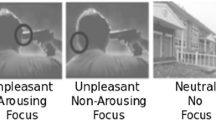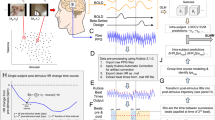Abstract
Previous research has demonstrated that negative affect influences attentional processes. Here, we investigate whether pre-experimental negative affect predicts a hypervigilant neural response as indicated by increased event-related potential amplitudes in response to neutral and positive visual stimuli. In our study, seventeen male participants filled out the German version of the positive and negative affect schedule (Watson et al. in J Pers Soc Psychol 54:1063–1070, 1988; Krohne et al. in Diagnostica 42:139–156, 1996) and subsequently watched positive (erotica, extreme sports, beautiful women) and neutral (daily activities) photographs while electroencephalogram was recorded. In line with our hypothesis, low state negative affect but not (reduced) positive affect predicted an increase in the first positive event-related potential amplitude P1 as a typical marker of increased selective attention. As this effect occurred in response to non-threatening picture conditions, negative affect may foster an individual’s general hypervigilance, a state that has formerly been associated with psychopathology only.




Similar content being viewed by others
References
Baas M, De Dreu CKW, Nijstad BA (2008) A meta-analysis of 25 years of mood-creativity research: Hedonic tone, activation, or regulatory focus? Psychol Bull 134:779–806
Bar-Haim Y, Lamy D, Glickman S (2005) Attentional bias in anxiety: a behavioral and ERP study. Brain Cogn 59:11–22
Carretié L, Hinojosa JA, Martín-Loeches M, Mercado F, Tapia M (2004) Automatic attention to emotional stimuli: neural correlates. Hum Brain Mapp 22:290–299
Clark VP, Hillyard SA (1996) Spatial selective attention affects early extrastriate but not striate components of the visual evoked potential. J Cogn Neurosci 8:387–402
Crawford LE, Cacioppo JT (2002) Learning where to look for danger: integrating affective and spatial information. Psychol Sci 13:449–453
Crawford JR, Henry JD (2004) The positive and negative affect schedule (PANAS): construct validity, measurement properties and normative data in a large non-clinical sample. Br J Clin Psychol 43:245–265
Derryberry D, Reed MA (1998) Anxiety and attentional focusing: trait, state and hemispheric influences. Pers Indiv Dif 25:745–761
Derryberry D, Reed MA (2002) Anxiety-related attentional biases and their regulation by attentional control. J Abnorm Psychol 111:225–236
Easterbrook JA (1959) The effect of emotion on cue utilization and the organization of behavior. Psychol Rev 66:183–201
Eysenck MW (1988) Anxiety and attention. Anxiety Res 1:9–15
Eysenck MW (1992) Anxiety: the cognitive perspective. Erlbaum, Hove
Finucane AM (2011) The effect of fear and anger on selective attention. Emotion 11:970–974
Finucane AM, Power MJ (2010) The effect of fear on attentional processing in a sample of healthy females. J Anxiety Disord 24:42–48
Forgas JP (2000) Affect and information processing strategies: an interactive relationship. In: Forgas JP (ed) Feeling and thinking: the role of affect in social cognition. Cambridge University Press, Cambridge, pp 253–280
Gable PA, Harmon-Jones E (2010) The blues broaden, but the nasty narrows: attentional consequences of negative affects low and high in motivational intensity. Psychol Sci 21:211–215
Gable PA, Harmon-Jones E (2011) Attentional states influence early neural responses associated with motivational processes: local vs. global attentional scope and N1 amplitude to appetitive stimuli. Biol Psychol 87:303–305
Gasper K, Clore GL (2002) Attending to the big picture: mood and global versus local processing of visual information. Psychol Sci 13:34–40
Gomez CM, Clark VP, Fan S, Luck SJ, Hillyard SA (1994) Sources of attention-sensitive visual event-related potentials. Brain Topogr 7:41–51
Heinze HJ, Mangun GR, Burchert W et al (1994) Combined spatial and temporal imaging of brain activity during visual selective attention in humans. Nature 372:543–546
Hillyard SA, Vogel EK, Luck SJ (1998) Sensory gain control (amplification) as a mechanism of selective attention: electrophysiological and neuroimaging evidence. Philos Trans R Soc Lond B Biol Sci 353:1257–1270
Junghöfer M, Elbert T, Tucker DM, Rockstroh B (2000) Statistical control of artifacts in dense array EEG/MEG studies. Psychophysiology 37:523–532
Kolassa IT, Kolassa S, Musial F, Miltner WHR (2007) Event-related potentials to schematic faces in social phobia. Cogn Emot 21:1721–1744
Krohne HW, Egloff B, Kohlmann CW, Tausch A (1996) Untersuchungen mit einer deutschen Version der “positive and negative affect schedule” (PANAS). Diagnostica 42:139–156
Kropotov J (2010) Quantitative EEG, event-related potentials and neurotherapy. Academic Press, Cambridge
Kuhr B, Schomberg J, Gruber T, Quirin M (2013) Beyond pleasure and arousal: appetitive erotic stimuli modulate electrophysiological brain correlates of early attentional processing. NeuroReport 24:246–250
Li W, Zinbarg RE, Paller KA (2007) Trait anxiety modulates supraliminal and subliminal threat: brain potential evidence for early and late processing influences. Cogn Affect Behav Neurosci 7:25–36
Loewenstein G, Lerner JS (2003) The role of affect in decision making. In: Davidson RJ, Scherer KR, Goldsmith HH (eds) Handbook of affective science. Oxford University Press, Oxford, pp 619–642
Luck SJ, Woodman GF, Vogel EK (2000) Event-related potential studies of attention. Trends Cogn Sci 4:432–440
Michalowski JM, Melzig CA, Weike AI, Stockburger J, Schupp HT, Hamm AO (2009) Brain dynamics in spider-phobic individuals exposed to phobia-relevant and other emotional stimuli. Emotion 9:306–315
Michalowski JM, Pané-Farré CA, Löw A, Hamm AO (2015) Brain dynamics of visual attention during anticipation and encoding of threat- and safe-cues in spider-phobic individuals. Soc Cogn Affect Neurosci 10:117–1186
Olofsson JK, Nordin S, Sequeira H, Polich J (2008) Affective picture processing: an integrative review of ERP findings. Biol Psychol 77:247–265
Pacheco-Unguetti AP, Acosta A, Callejas A, Lupiáñez J (2010) Attention and anxiety different attentional functioning under state and trait anxiety. Psychol Sci 21:298–304
Pessoa L, McKenna M, Gutierrez E, Ungerleider LG (2002) Neural processing of emotional faces requires attention. Proc Natl Acad Sci USA 99:11458–11463
Polich J, Kok A (1995) Cognitive and biological determinants of P300: an integrative review. Biol Psychol 41:103–146
Portella C et al (2012) Relationship between early and late stages of information processing: an event-related potential study. Neurol Int 4:e16
Pourtois G, Grandjean D, Sander D, Vuilleumier P (2004) Electrophysiological correlates of rapid spatial orienting towards fearful faces. Cereb Cortex 14:619–633
Rowe G, Hirsh JB, Anderson AK (2007) Positive affect increases the breadth of attentional selection. Proc Natl Acad Sci USA 104:383–388
Smith NK, Cacioppo JT, Larsen JT, Chartrand TL (2003) May I have your attention, please: electrocortical responses to positive and negative stimuli. Neuropsychologia 41:171–183
Smith NK, Larsen JT, Chartrand TL, Cacioppo JT, Katafiasz HA, Moran KE (2006) Being bad isn’t always good: affective context moderates the attention bias toward negative information. J Pers Soc Psychol 90:210–220
Storbeck J, Clore GL (2005) With sadness comes accuracy; with happiness, false memory mood and the false memory effect. Psychol Sci 16:785–791
Vermeulen N (2010) Current positive and negative affective states modulate attention: an attentional blink study. Pers Indiv Dif 49:542–545
Vogel EK, Luck SJ (2000) The visual N1 component as an index of a discrimination process. Psychophysiology 37:190–203
Watson D, Clark LA, Tellegen A (1988) Development and validation of brief measures of positive and negative affect: the PANAS scales. J Pers Soc Psychol 54:1063–1070
Weinberg A, Hajcak G (2011) Electrocortical evidence for vigilance-avoidance in Generalized Anxiety Disorder. Psychophysiology 48:842–851
Acknowledgments
We thank Rainer Düsing, Sebastian Gasse, Jakob Kaiser, and Carina Krause for their assistance in stimulus selection and data collection. In particular, we thank Playboy Germany for providing us with picture material.
Author information
Authors and Affiliations
Corresponding author
Ethics declarations
Conflict of interest
The authors declare that they have no conflict of interest.
Rights and permissions
About this article
Cite this article
Schomberg, J., Schöne, B., Gruber, T. et al. Emotion and hypervigilance: negative affect predicts increased P1 responses to non-negative pictorial stimuli. Exp Brain Res 234, 1395–1402 (2016). https://doi.org/10.1007/s00221-015-4544-x
Received:
Accepted:
Published:
Issue Date:
DOI: https://doi.org/10.1007/s00221-015-4544-x




